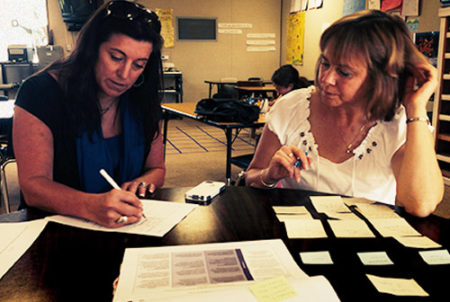As the shift to Common Core State Standards (CCSS) moved into high gear, the County Office Curriculum and Instruction Department took the lead in ensuring that English learners would not be left behind. Trainings for administrators, classroom teachers and instructional coaches to raise the awareness of and support implementation of the new California English Language Development Standards have been a priority.
 Though the CCSS are intended to be the standards for all children, regardless of English language proficiency, the authors of the Standards clearly state that “It is also beyond the scope of the Standards to define the full range of supports appropriate for English language learners and for students with special needs.” The CA ELD Standards were adopted by California in 2012 to support teachers working with English learners and CCSS. The state committee that wrote the Standards carefully examined the CCSS and developed the ELD Standards to highlight the additional instruction that English learners would need to be successful with the Common Core. Though the Standards were adopted in late 2012, the focus in 2013-14 was on building awareness of the Standards, which still seemed “new” to many.
Though the CCSS are intended to be the standards for all children, regardless of English language proficiency, the authors of the Standards clearly state that “It is also beyond the scope of the Standards to define the full range of supports appropriate for English language learners and for students with special needs.” The CA ELD Standards were adopted by California in 2012 to support teachers working with English learners and CCSS. The state committee that wrote the Standards carefully examined the CCSS and developed the ELD Standards to highlight the additional instruction that English learners would need to be successful with the Common Core. Though the Standards were adopted in late 2012, the focus in 2013-14 was on building awareness of the Standards, which still seemed “new” to many.
The Santa Cruz County Office of Education sponsored a series of four visits to Santa Cruz by WestEd’s Pam Spycher, principal author of the CA ELD Standards and an author of the forthcoming CA ELA (English Language Arts)/ELD Framework. Dr. Spycher worked with administrators, secondary ELD teachers and K-5 classroom teachers presenting instructional strategies that exemplify the Standards such as collaborative summarizing, text reconstruction, sentence unpacking and joint text construction. The half-day workshops were extremely well-received. Typical comments included: “All of the information and activities were extremely helpful—I am feeling extremely motivated to share with my site” and “I loved that this training was focused on strategies and collaboration.”
Dr. Spycher’s presentations also formed the centerpiece of the COE’s EL Coach Network. The EL Coach Network, comprised of instructional coaches and lead teachers from districts across the county, met monthly to deepen their own understanding of the ELD Standards. They participated in an ongoing learning community with Dr. Spycher, meeting with her for four afternoons to understand the new Standards and the implications for instruction in both Designated ELD and Integrated ELD. In between these presentations, the group met to discuss their implementation of what they were learning. In addition to doing professional reading around the Standards, the group selected text reconstruction as a focal strategy. Different members tried out strategies of text reconstruction in classrooms and then returned to present their experiences and share student work generated from the lesson.
Secondary ELD teachers from Santa Cruz City Schools and Soquel Union Elementary School District also made learning about the ELD Standards the focus of their monthly Professional Learning Community (PLC) meetings. Secondary ELD teachers are often the only ones at their school with the assignment so this opportunity to collaborate across schools and districts was highly valued by participants. Teachers spent time reading and discussing the Standards together as well as sharing strategies. At each meeting, teachers brought student work which the group then analyzed in terms of the new ELD Standards. In addition to this PLC in the northern half of the county, the County Office collaborated with Pajaro Valley Unified School District to provide training on the new ELD Standards to secondary ELD teachers in Watsonville and Aptos.
Common Core training offered by the County Office for administrators and classroom teachers also addressed the CA ELD Standards. The Going Deeper training for classroom teachers offered them the opportunity to experience a model unit that integrated Science, English Language Arts (ELA) and ELD Standards. Teachers learned to use text reconstruction as a strategy to integrate ELD into their ELA lessons.
The response to the CA ELD Standards and professional learning around the Standards has been overwhelmingly positive. “This is the best Professional Development I have had all year,” remarked one participant. A formula for successful professional learning includes: a firm grounding in the Standards; a hands-on approach that allows teachers to learn new instructional strategies by experiencing them; fostering relationships between teachers so that teachers feel safe, allowing them to take risks and learn from each other; the expectation that they will apply the strategy presented and the opportunity to return and reflect on their experience so that learning goes deeper; and a focus on the results of instruction by looking at student work.
A good resource for more information on the California ELD Standards, are the Professional Learning Modules on Brokers of Expertise. To find out more about scheduling professional development for your staff on the CA ELD Standards, the new ELA/ELD Framework and the strategies mentioned here, or to join the EL Coach Network or Secondary ELD Teacher PLC, please contact Sofia Sorensen, Coordinator, Santa Cruz COE.
